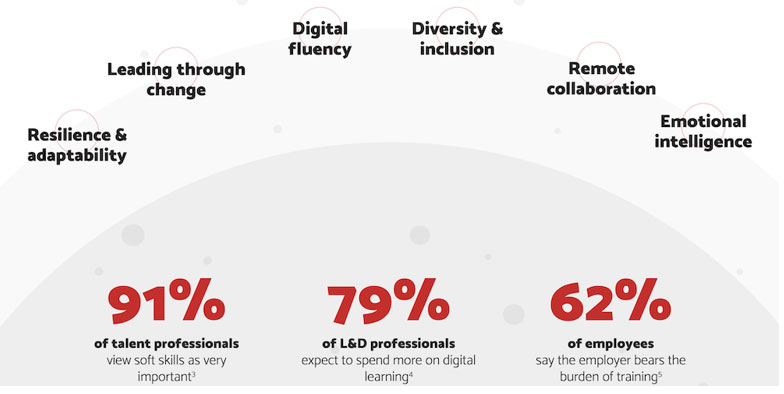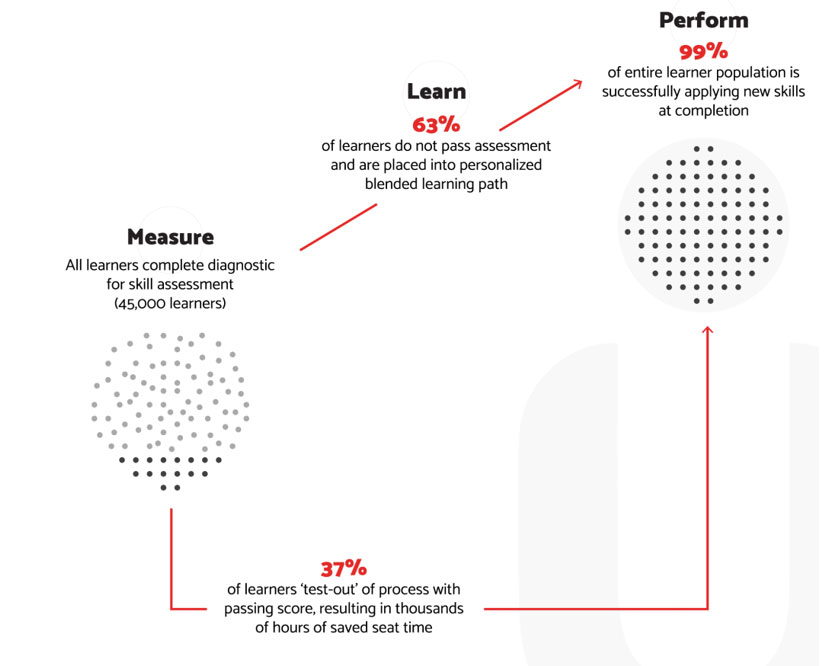What Naturally Follows the Great Resignation? A Reskilling & Upskilling Revolution

With Covid-19 throwing a wrench into almost all organizations’ plans, it’s to no one’s surprise that a lot of the way we go about business has changed.
Along with the “Great Resignation,” company leadership has faced new challenges, but none more so than retaining valuable staff. It is more important than ever that employees who have stayed on not only feel like they are capable of taking on the new responsibilities that are now expected of them, but that they are valued and respected.
Many successful leaders are turning the Great Resignation on its head and thinking of it, instead, as the Great Retention — and retention starts with a reskilling and upskilling revolution.
How to Retain Employees in a Hybrid World
We all know that employees were allowed to work from home at the peak of the pandemic. Some left. Some stayed. Some had no trouble adapting to this new digital age, while others struggled.
Many organizations fell short in supporting their workforce, and didn’t offer any upskilling or reskilling opportunities. When restrictions were loosened, a frustrated workforce resulted.
Another part of the cause of the Great Resignation is that not many employees wanted to go back to the office and wanted to keep working remotely. This has resulted in many businesses adopting a hybrid model, and new skill sets are again necessary to adapt to the demands of the current corporate environment.
Training and development are nothing new for the business world, but for the first time, we are utilizing them in ways to appeal to a mass of remote and hybrid workers in the wake of one of the most significant cultural shifts in our lifetime.
Retaining the workforce comes down to engagement, and reskilling and upskilling is one such way to do this.
Addressing a Skills Gap
All leadership is aware that a partially skilled and trained employee is better than an untrained new hire. According to the Society for Human Resource Management, the average cost to hire an employee is $4,129, with around 42 days to fill a position. It is even more costly and time-consuming to replace someone instead of filling a new job, which can cost 50-60% of the employee’s annual salary.
So, why aren’t more businesses addressing the problem of retention sooner?
An employee may be 70 percent of the way ready for a more prominent role in the company, but just needs some extra training. Identifying and addressing the skill gaps in an organization can reduce churn and increase employee satisfaction, supporting the long-term financial goals of the business and the individual.
Figure 1: Human skills reign supreme
Reskilling and Upskilling for Retention
Employees genuinely see upskilling as hugely positive. By offering skill-building programs, it changes the perception not only of talent management but also how employees perceive the company.
Upskilling at scale also provides a common experience for all employees. For example, one global professional services organization introduced an upskilling initiative for all employees based on agile methods and digital fluency. Employees who participated developed a new common language in the area, which has now permeated the organization. People proudly display the badges achieved in these programs to others. The program not only enhanced skills, but it also created a sense of culture and camaraderie among team members.
So how, exactly, can businesses utilize reskilling and upskilling for engagement, job satisfaction, and, ultimately, retention?
Where leadership needs to start is to recognize that people develop skills through experience and practice. It has to be in the right context. CEOs also need to ask for measurement of the impact of the L&D programs. This goes beyond how people rate training programs, but through accurate, usable data.
This is why situational-based immersive simulations are the only type of training that uniquely delivers the ability to practice in context, scales the initiative, and delivers real-time usable data.
Figure 2: Upskilling at scale example – new skills across the enterprise
A Revolution Beyond eLearning
There has been a lot of focus on eLearning; however, what leadership needs to get right is whether this digital training addresses skill gaps, works in practice, and can be measured — even better, if it builds culture and sense of community.
Immersive simulations have had thus far the most impactful results when it comes to upskilling employees in the hybrid workforce. It’s effective, works remotely and is cost-efficient. You may upskill your employees 15x faster with learning materials rated 85% effective, and it yields up to a 66% reduction in learner seat time.
Educating workers to lead through change, being digitally fluent, collaborating better remotely, and bringing to the forefront emotional intelligence through these simulations will better cater to the varying needs of employees during this digital transformation and the Great Retention.
Written by Michael Veale, CEO & President of ETU.
Bring the best of the CEOWORLD magazine's global journalism to audiences in the United States and around the world. - Add CEOWORLD magazine to your Google News feed.
Follow CEOWORLD magazine headlines on: Google News, LinkedIn, Twitter, and Facebook.
Copyright 2025 The CEOWORLD magazine. All rights reserved. This material (and any extract from it) must not be copied, redistributed or placed on any website, without CEOWORLD magazine' prior written consent. For media queries, please contact: info@ceoworld.biz










